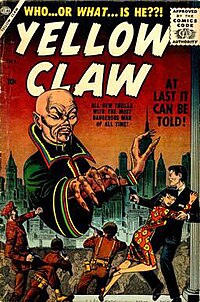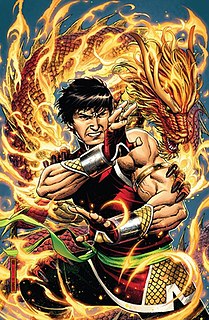
Shang-Chi, also known as the Master of Kung Fu and Brother Hand, is a superhero appearing in American comic books published by Marvel Comics. The character was created by writer Steve Englehart and artist Jim Starlin, debuting in Special Marvel Edition #15 in the Bronze Age of Comic Books, and starring in his own solo title until 1983. Shang-Chi is proficient in numerous unarmed and weaponry-based wushu styles, including the use of the gùn, nunchaku, and jian.

Timely Comics is the common name for the group of corporations that was the earliest comic book arm of American publisher Martin Goodman, and the entity that would evolve by the 1960s to become Marvel Comics.

Colonel Nicholas Joseph "Nick" Fury is a fictional character appearing in American comic books published by Marvel Comics. Created by writer/artist Jack Kirby and writer Stan Lee, he first appeared in Sgt. Fury and his Howling Commandos #1, a World War II combat series that portrayed the cigar-chomping man as leader of an elite U.S. Army Ranger unit.

James F. Steranko is an American graphic artist, comic book writer/artist, comics historian, magician, publisher and film production illustrator.
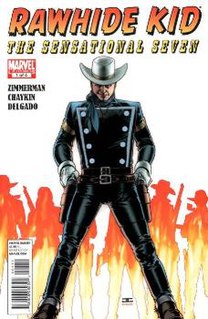
The Rawhide Kid is a fictional Old West cowboy appearing in American comic books published by Marvel Comics. A heroic gunfighter of the 19th-century American West who was unjustly wanted as an outlaw, he is one of Marvel's most prolific Western characters. He and other Marvel western heroes have on rare occasions guest-starred through time travel in such contemporary titles as The Avengers and West Coast Avengers. In two mature-audience miniseries, in 2003 and 2010, he is depicted as gay.
Strange Tales is a Marvel Comics anthology series. The title was revived in different forms on multiple occasions. Doctor Strange and Nick Fury, Agent of S.H.I.E.L.D. made their debuts in Strange Tales. It was a showcase for the science fiction/suspense stories of artists Jack Kirby and Steve Ditko, and for the groundbreaking work of writer-artist Jim Steranko. Two previous, unrelated magazines also bore that title.
Amazing Adventures is the name of several anthology comic book series, all but one published by Marvel Comics.

Sgt. Fury and his Howling Commandos was a comic book series created by Jack Kirby and Stan Lee and published by Marvel Comics from 1963 to 1981. The main character, Sgt. Nick Fury, later became the leader of Marvel's super-spy agency, S.H.I.E.L.D. The title also featured the Howling Commandos, a fictional World War II unit that first appeared in Sgt. Fury and his Howling Commandos #1.
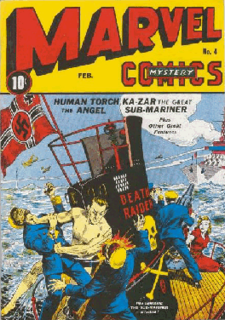
Marvel Mystery Comics is an American comic book series published during the 1930s–1940s period known to fans and historians as the Golden Age of Comic Books. It was the first publication of Marvel Comics' predecessor, Timely Comics, a division of Timely Publications.

Not Brand Echh is a satiric comic book series published by Marvel Comics that parodied its own superhero stories as well as those of other comics publishers. Running for 13 issues, it included among its contributors such notable writers and artists as Stan Lee, Jack Kirby, Gene Colan, Bill Everett, John and Marie Severin, and Roy Thomas. With issue #9, it became a 68-page, 25¢ "giant", relative to the typical 12¢ comics of the times. In 2017, a 14th issue was released.

Vision (Aarkus) is a fictional superhero appearing in American comic books published by Marvel Comics. Created by the writer Joe Simon and artist Jack Kirby, the character first appeared during the Golden Age of comic books in Marvel Mystery Comics #13, published by Marvel predecessor Timely Comics.

Joseph Maneely was an American comic book artist best known for his work at Marvel Comics' 1950s predecessor, Atlas Comics, where he co-created the Marvel characters the Black Knight, the Ringo Kid, the Yellow Claw, and Jimmy Woo.

The Agents of Atlas are a fictional superhero team appearing in American comic books published by Marvel Comics. The first lineup was composed of characters originally appearing in unrelated stories published in the 1950s by Marvel's predecessor company, Atlas Comics. The characters debuted as a team in What If #9 and starred in the 2006 limited series Agents of Atlas, written by Jeff Parker and with art by Leonard Kirk.
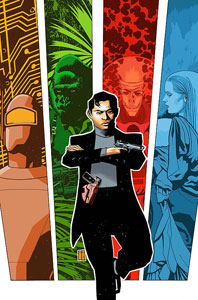
James Woo is a fictional secret agent appearing in American comic books published by Marvel Comics. Created by EC Comics writer Al Feldstein and artist Joe Maneely, the Chinese-American character first appeared in Yellow Claw #1 from Atlas Comics, the 1950s predecessor of Marvel. Woo has since appeared occasionally in a variety of Marvel publications.
Strange Worlds was the name of two American science-fiction anthology comic-book series of the 1950s, the first published by Avon Comics, the second by a Marvel Comics predecessor, Atlas Comics. Each featured work by such major comics artists as Steve Ditko, Jack Kirby, Joe Kubert, and Wally Wood.

Fu Manchu is the name of a fictional supervillain appearing in American comic books published by Marvel Comics. Based on the character of the same name, he is the father and arch-enemy of Shang-Chi.
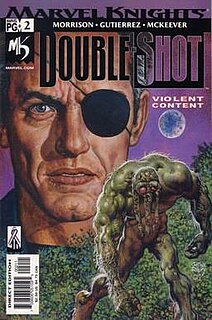
"Nick's World" is a twelve-page comic book story featured in the second issue of Marvel Knights: Double Shot written by Grant Morrison and drawn by Manuel Gutiérrez. The story concerns a young spy who tries to trick Nick Fury. The story was originally intended to be a part of a much longer series but after the follow-up series proposal was ignored by Marvel, Morrison incorporated much of the psychedelic super-spy material into their Vertigo title The Filth.

"Nick Fury, Agent of S.H.I.E.L.D." was a feature in the comics anthology Strange Tales which began in 1965 and lasted until 1968. It introduced the fictional spy agency S.H.I.E.L.D. into the Marvel Comics world and reintroduced the character of Nick Fury as an older character from his concurrently-running series Sgt. Fury and his Howling Commandos, which was a series set during World War II. The feature replaced the previously running Human Torch feature in the book and ran alongside the Doctor Strange feature. After the feature ended, a comic book series was published which has had several volumes as well as a comic strip. The feature was originally created by the duo of Stan Lee and Jack Kirby who also created the original Sgt. Fury series but it was later taken over by artist and writer Jim Steranko. The feature was often censored by the Comics Code Authority due to Jim Steranko's provocative art; this art helped change the landscape of comics which Steranko continued with in the 1968 ongoing series. Much of Nick Fury's supporting cast originated in the feature and many of the devices used by these characters were often used in other comics published by Marvel.
